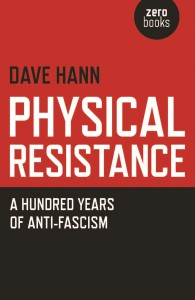Book Review: A century of antifascism
This article appeared in the 35th issue of the newsletter of the International Brigade Memorial Trust and is reprinted here with the IBMT’s permission.
Although “Physical Resistance” is a history of the antifascist movement in Britain from 1924 to 2010, it includes a substantial chapter on the Spanish Civil War, and testimony from International Brigaders runs throughout much of the book. Howard “Andy” Andrews, Lou Kenton, Bernard McKenna and Alun Menai Williams are four of the 20 anti-fascists interviewed by author Dave Hann between 2005 and early 2009.
The words of the participants in anti-fascism, from the communists who disrupted Oswald Mosley’s open air meetings in the 1930s to the anarchists involved in blocking English Defence League marches today, are at the heart of the book. The book was completed following the death of Dave Hann in September 2009 (see IBMT Newsletter 25, New Year 2010). Its editor, Louise Purbrick, calls “Physical Resistance” an activist’s history: it is written by an anti-fascist about anti-fascists.
Dave Hann pieced together a history encompassing almost 100 years, using numerous leftwing pamphlets, national and local newspaper reports as well as academic texts. But it is the anti-fascists themselves who tell the story of well-known victories, such as the Battle of Cable Street, alongside small acts of bravery that never merited a headline but without which there would have been no victories.
For example, Benny Rothman, a young north Manchester communist, arrived at a Mosley meeting in Belle Vue straight from work, still in his mechanics overalls, to be given the task of leafleting it. Before he began, he observed the actions of Evelyn Taylor**. She “…stood up on the balcony opposite and started barracking Mosley… So they sent some women Blackshirt stewards to get her out but she hit out at them and knocked them down. Then they sent the men over to sort her out and it was absolute mayhem.”
It was then that Benny Rothman threw his leaflets into the crowd. Dave Hann’s skill as historian lay in the understanding that everyday experiences, like arriving at a meeting in the wrong clothes to be persuaded to distribute leaflets, were part and parcel of momentous historical occasions. This holds true for his account of the Spanish Civil War. The formation of the International Brigades, the training and manoeuvres of the British Battalion, through to their withdrawal from Spain, are told through the personal experience of the Brigaders.
Small details reveal the humanity and dignity of the fight against fascism. Bernard McKenna recalled the effect of Mussolini’s North African campaign in his decision to go to Spain. “I was appalled and horrified by the suffering of the Abyssinian people.” Alun Menai Williams remembered his concern for his mother as he made up his mind to join the International Brigades. Bob Doyle told of the heat of the rifle he used in the defence of Belchite and the “terrific noise” of the fascist advance. Lou Kenton spoke of witnessing “a sight one could never forget” as Catalans fled into France as the war ended – “mothers carrying children who were already dead”.
The actions of International Brigaders stand out within the narrative of “Physical Resistance”. This is not only because of their extraordinary commitment and exceptional courage but because their fight in Spain, unlike the daily round of anti-fascist activities that took place in local streets and local meetings, was outside everyday life. However, Hann asserts the place of the Spanish Civil War in the history of the anti-fascist movement in Britain.
International Brigaders were, of course, part of this movement both before and after their journeys in Spain. In 1935, Alun Menai Williams was busy in London running around with his “mate Billy and his band of communists, anarchists and other assorted hopefuls” who “would heckle anddisrupt Blackshirt meetings wherever they found them”. Two decades later, Bob Doyle, in the first car he ever owned, a Ford Popular, used it to rescue young West Indians from being assaulted by racist gangs in Notting Hill.
There are many more such examples of the continuous commitment of anti-fascists to the fight, often the physical fight, against prejudice, racism and nationalism. And, it is this long view established by “Physical Resistance” which makes it possible to see how the struggles of past, and especially the Spanish Civil War, have informed, even inspired, those of the present.
*To order a copy for £15 (price includes a donation to anti-fascist prisoners) contact: [physicalresistance@riseup.net].
**Evelyn Taylor was the wife of George Brown, who was killed at the Battle of Brunete in July 1937. She later married International Brigader Jack Jones, who became leader of the Transport & General Workers’ Union (and later the IBMT’s Life President).
Sarah Abott is a member of Brighton Anti-Fascists













